When You Hit An Object In The Road
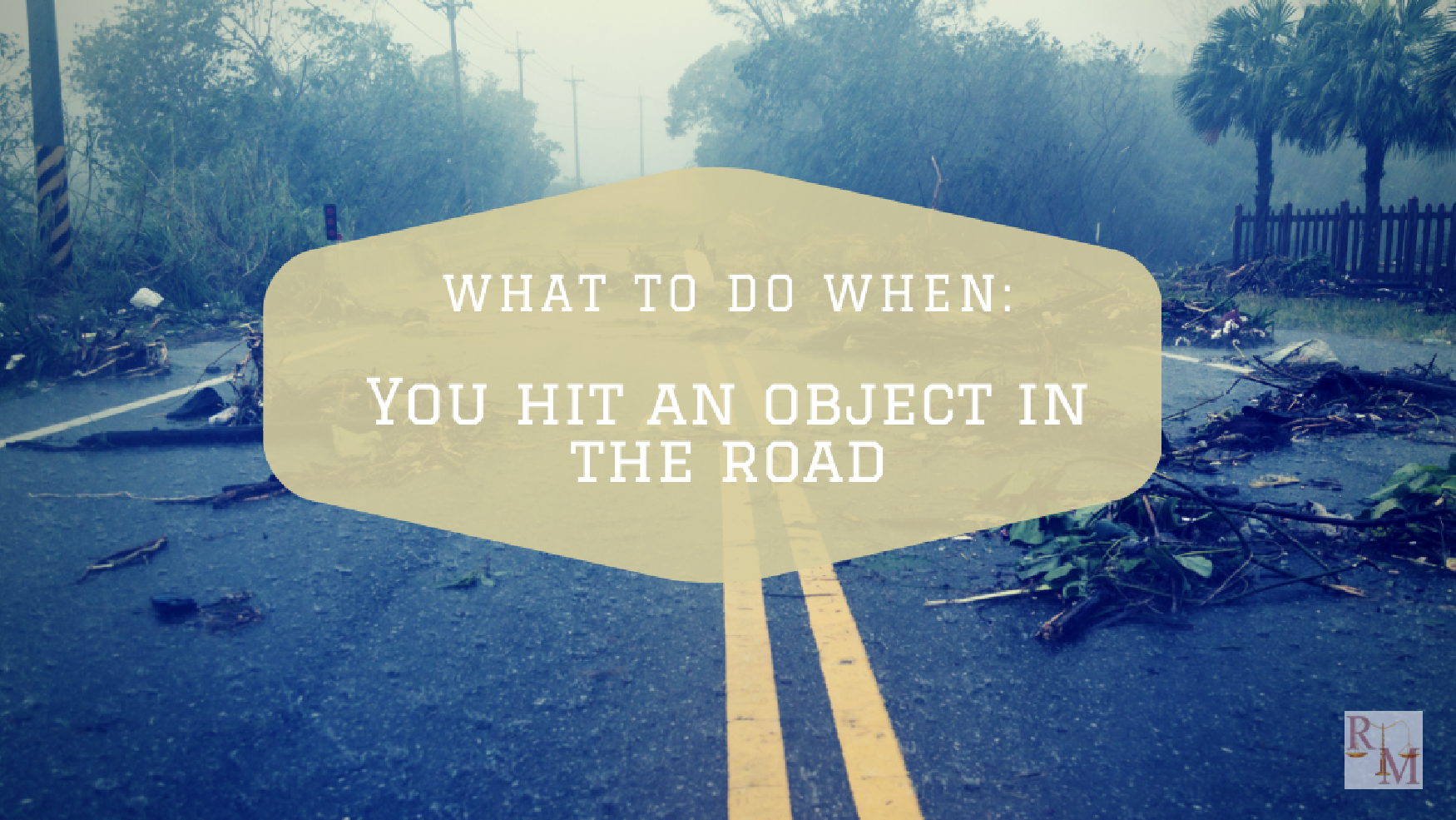
No one wants to be in a collision, but accidents can occur when you least expect them to. The same is true for single car incidents when a driver hits an object in the road. However, if the object is unavoidable and there is damage to your car, what happens next and who is “at fault”?
Stationary vs Flying Objects
The nature of an insurance claim is determined by the type of object hit; naturally, there is good news and bad news. The good news is that if an object came flying at your car, such as a piece of broken truck tire or falling rock, there was no time to react, and the object was in midair when you hit it, then it is a comprehensive claim, as opposed to an at-fault, collision claim which you file for hitting a stationary object. In either scenario however, if you want or need to file a claim to repair the vehicle, you will have a deductible and, in the latter scenario, your insurance may go up.
Avoiding An Object
It’s said that if you are driving and an animal darts in front of you, or is simply stopped in the road, that you should plan on hitting it, rather than swerve to avoid it. The reason behind this thinking is that, the average driver is not as aware of their surroundings as they really should be and swerving to avoid the animal might cause more damage or injury. This is not to say that you should plan on running straight into an object on the road before you, but to say that, as a driver, you have the responsibility to be aware of not only your immediate surroundings but of what lays ahead. If you can safely avoid the object without hitting another car, or risking a more dangerous situation, than you should avoid it. As soon as you realize the situation, begin to decelerate and quickly take stock of what is around you. Obviously, avoiding any type of collision is the goal, but a collision with a bush is better than a collision with a concrete barrier.
Drive Smart
We’ve all seen it- a twenty year old pickup truck, loaded to the gills with rickety pieces of wood and debris precariously strapped in, and swaying to the motion of every movement. The best advice? Stay far away from those vehicles. As with life in general; while we can’t avoid every surprise life will throw at us, we can make the decision to avoid the obviously dangerous situations. If you get behind a vehicle that makes you nervous, move over or pull over until they are away from you. It’s simply not worth the white-knuckle driving you would have to do being in their vicinity.
The lawyers at the Law Offices of Robert L. Meissner are experienced in getting people who have been injured the compensation they deserve. If you are looking for a Sacramento auto accident attorney, please call (916) 863-2900, or fill out our online form for a free consultation.
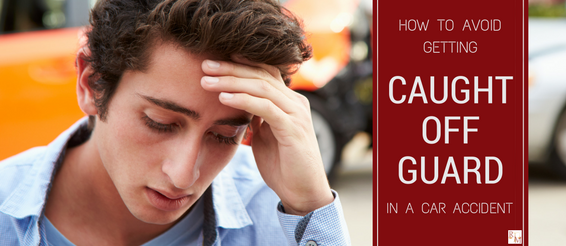
No one gets into their car planning to have an accident, but more often than not, these things are outside of our control. While we all hope for the best, it is important to prepare for the worst.
According to the National Highway Traffic Safety Administration, over 2.3 million people were killed or injured in car accidents in 2014. Young drivers are at an even higher risk – motor vehicle crashes are the leading cause of death for 15-20 year-olds. For you and your family’s safety, it’s important to have a plan in place in case of a car accident that you communicate to all the drivers in your family. Here are a few things your plan should include:
Get out of the road
After an accident, you should strive to get your car to the side of the road as quickly as possible. The presence of a crashed car in the middle of the road can lead to additional injuries. If, for whatever reason, the car cannot be moved, everyone should stay inside the car – don’t go out into a busy street! – with their seat-belts fastened and hazard lights on.
Put together an emergency kit
An emergency kit is crucial in case an accident results in injuries. The kit should include a cell phone, a first aid kit, emergency contact numbers, and a list of any medications or allergies that car occupants have. You’ll also want to include a flashlight, batteries, and road flares in case an accident occurs at night. A fire extinguisher is also a good thing to have on hand.
If you regularly go on off-road trips, out to trails, or other places where help may take longer getting to you; you’ll want to consider adding a few more items as well, such as blankets, granola and protein bars, and water. Some water bottles are packaged to have a long shelf-life.
Insurance and information
While you’re putting together an emergency kit you should consider what you’ll need to record the accident. Include paper, a pad, and a pen (to take down information from the other driver or from witnesses), a disposable camera to take pictures of the damage, and your own insurance information and contact numbers.
After the accident
Once you have safely handled the immediate aftermath of the accident, there are two things you’ll want to do. The first is getting a full checkup at the emergency room. Just because you have no visible wounds or bruises, that doesn’t mean you have not sustained any internal injuries. Car accidents can result in serious brain, head, neck, and spinal cord injuries, some of which can be fatal. It is therefore crucial that you go to a hospital and inform medical professionals that you have been in a car accident.
Finally, you’ll want to be sure to report your accident and speak to a Sacramento auto accident attorney as soon as possible. If there are no injuries, police may not arrive to the scene. However, you should still file a report with your local police department, as this record can be important for insurance purposes.
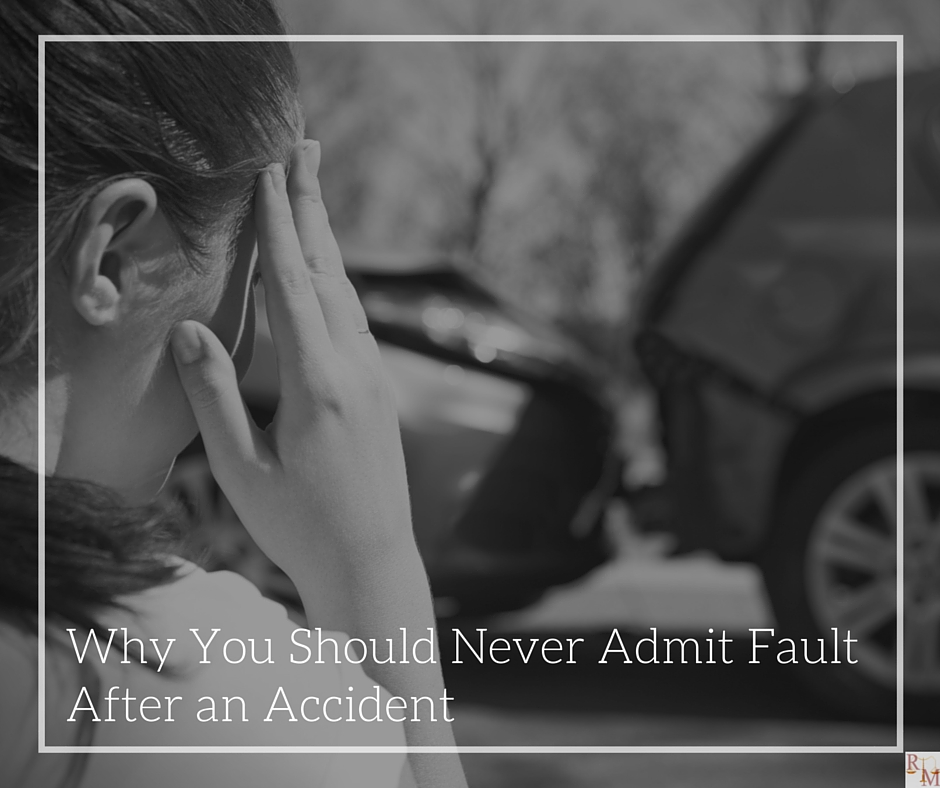
Moments after an auto accident, you begin to notice injuries to passengers and damage to your vehicle. After checking to see if everyone is alright, the next big question often asked after a car crash is, “whose fault was the accident?” Some drivers involved in auto accidents are eager to assign fault and will blame the other motorist, while others might apologize for their actions. Regardless of who was at fault, this question can significantly impact the outcome of a personal injury case. While assigning fault outside an official police or witness report seems natural after the trauma of an auto accident, it can come back to haunt you in personal injury cases.
The dangers of admitting fault
Prior to admitting fault in an automobile accident, there are a number of important factors to consider. Admitting fault can result in you paying more money if you are the defendant or receiving less compensation if you are the plaintiff. In many states, personal injury lawsuits can seek compensation based on a percentage of fault. For example, one driver can be found 10 percent responsible while the other motorist can be found 90 percent responsible for the accident. This percentage can be distorted if you admit fault at the scene of an auto accident or in conversation with the other driver.
Since auto accidents can be extremely stressful and emotional situations, you might admit fault without even knowing it. After cleaning up the scene and going home, you might want to talk about an accident with trusted friends and loved ones. However, it is important to watch what you say on social media, as posts such as status updates and photos can be used in court as evidence of fault. For more tips on using social media before or during a personal injury lawsuit, check out this blog.
Speak very carefully
Following a personal injury accident, it is vital that you make an effort to not say anything that can be viewed as incriminating evidence. Anything along the lines of, “I’m sorry,” or “I didn’t see you,” can be used as evidence of fault in court. While it is common decency to acknowledge regret or disapproval for an auto accident, remember that you do not have to determine whose fault it was. Let police and witness reports, photographs and other official evidence determine fault, rather than a knee-jerk reaction after an accident.
Bottom line, never admit fault when you are involved in an auto accident. Let the police and your attorney take care of the details to avoid landing yourself in hot water. If you or someone you know has been involved in an accident, it is important to speak with a qualified Sacramento personal injury attorney. For more information or to set up a consultation, call Robert L. Meissner today at (916) 473-1537.
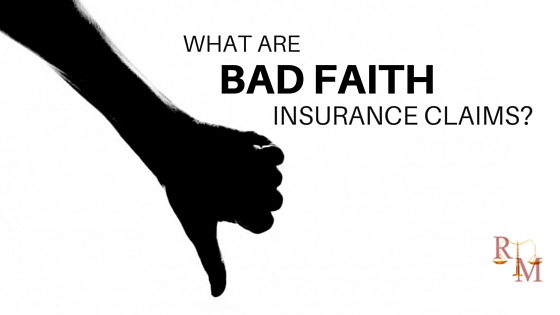
As you’ve likely deduced from reading previous blog posts, the insurance companies are not always on your side. One of the most egregious methods used by insurance companies to take advantage of their customers during tough times is to deny an injury claim in bad faith. If you’ve been injured in an accident, you may be wondering how much your case is worth – and to have your case denied can be devastating. To fight back against greedy insurance providers, it is important to understand exactly what a bad faith claim entails, why insurance companies deny claims and how you can get the money you deserve. Read ahead to find out how you can take the insurance companies to court if your case was denied in bad faith.
What is Bad Faith?
In the simplest of terms, bad faith occurs when an insurance company denies an injury car accident claim without a reasonable explanation or basis for denial. This typically means that the insurance provider did not accurately document or appropriately investigate the claim. This unfortunately occurs quite frequently and can be tricky to prove negligence on the insurance companies.
Proving that an insurance company acted in bad faith can be difficult, but not impossible. If your insurance provider denies a claim due to a simple error or assessment mishap, this is usually not enough to constitute bad faith. For a case to be deemed bad faith, the policy owner must prove that their provider either failed to conduct a thorough investigation or ignored glaring evidence proving your claim. Your bad faith claim also has a good chance at succeeding if you can prove that the insurance company purposely performed an inadequate analysis of your case, in an attempt to stay ignorant of details that would prove your claim true.
Damages Available in Bad Faith Cases
If a case is found to be in bad faith, the policy owner can recover the initial claim amount, and possibly more due to negligence from the insurance provider. Consequential damages, which are rewarded as a result of a claim denial, can include the cost of the injury lawsuit, attorney’s fees and the cost of bringing suit against the insurance company.
You may also be able to receive damages that stem from the emotional agony created by a bad faith injury claim. Additionally, if it can be proven that the insurance provider intentionally tried to injure you, punitive damages can be available. These damages will only be awarded if it can be proven that excessive and atrocious conduct were performed by the insurance company, not just a sloppy investigation.
It may seem like your back is against the wall if your car accident injury claim is denied. But with a trustworthy attorney on your side, you can prove that the insurance companies were acting in bad faith. Remember that it is your word against the insurance company’s, so make sure to take photos of your accident, obtain eyewitness accounts and record police testimonies to further prove your case.
Don’t be afraid of the big bad insurers, get the help you need to win your case today. For a free consultation with an attorney you can trust, call the offices of Robert L. Meissner today at (916) 473-1537 or fill out our online form.
Being involved in an auto accident while you weren’t wearing your seat belt doesn’t mean you can’t expect compensation. There are many elements that go into injury claims, especially when it involves serious injuries and suffering. In order to establish a basis for your claim you need to ask a vital question first; Who was responsible?
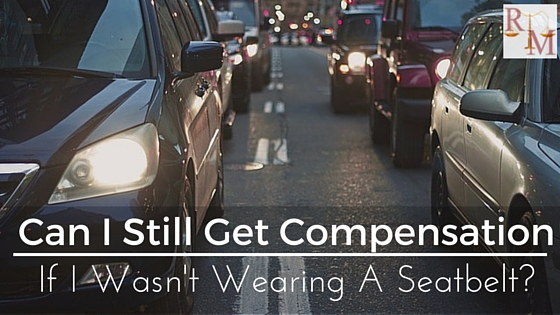
Building A Case
Every state has different laws regarding seat belts, but in the end they all say the same thing – never drive without them. Even though these laws are in place, it doesn’t automatically excuse the person that was responsible. If the other party caused the accident and you suffered an injury, you have a right to ask for compensation. However, there is a process involved and it could lead to complications.
The Factors
An investigation needs to take place, which needs to prove who was to blame. This is typically done by the police and legal parties. Unfortunately, this isn’t a flawless system and is also the reason lawyers launch their own inquiries. There are cases when police statements are inaccurate or incomplete and this will automatically affect your chances of making a successful claim, whether it’s in court or with your insurance company.
The second factor is based on the coverage of the responsible party. Is that person insured, and how much is the insurance company willing to pay? In many cases, insurance companies will try to throw out the claim completely or decrease the amount. In this particular instance they will try to penalize you for not wearing a seat belt. This is why legal representation is crucial. Like every other business, they are trying to turn a profit.
Establishing Compensation
There is no way to predict an actual amount, because everything involved with the accident plays a crucial part. Estimations have to be made according to certain details, such as the amount of pain you’ve suffered, your medical expenses, your ability to keep working and so forth. There may also be a question of future problems related to the injuries you sustained, which will require medical care. All of these things factor into how much compensation you can receive. Remember that the court will assign you a degree of fault, because technically you were breaking the law by not wearing your seat belt. This means that a percentage of the money that has been awarded to you has to go to the state.
If you have been involved in a car accident while not wearing a seatbelt, it’s important to seek legal counsel immediately. A personal injury attorney can help to ensure you have the best chance of fair representation, increasing the likelihood that you’ll receive compensation for any injuries. The Law Office of Robert L. Meissner provides experienced legal representation for those involved in auto accidents in Sacramento. Contact us at 916-473-1537 to speak with our staff and learn more about how we can help!
When evaluating a potential settlement on a personal injury case the most important factors are the type of injury and the extent of the injury’s severity. The type and severity of your injury is what determines the cost of the medical attention you will need and that cost is what the first thing any insurance adjuster will look at during any settlement negotiations. So let’s take a deeper look at the different categories of injury and what that may mean for your case.
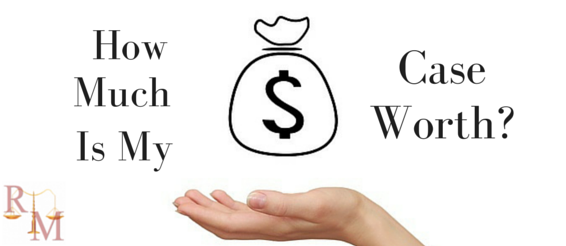
Soft Tissue Injuries
Essentially, insurance adjusters will put your injury into one of two categories, soft tissue injuries or hard tissue injuries. Soft tissue injuries are less severe, sprains and strains of muscle and soft connective tissue. As you can probably surmise, being less serious and quicker to heal, these injuries tend to end up on the lower end of the settlement spectrum. That does not mean you shouldn’t still consult with an injury attorney because every case is different and how and why your injury occurred also has a great bearing on your case.
Hard Tissue Injuries
Hard tissue injuries are more serious and therefore commonly garner a higher settlement. Hard tissue injuries include, but are not limited to: broken bones of any kind, separations, dislocations, ligament tears, head injuries, lacerations, and spine and vertebrae injuries.
Head or Brain Injuries
Anytime your claim is backed by medical evidence of how an injury has negatively impacted your life, it will increase the value of your claim. Head injuries in particular tend to add value to a claim because the long-term effects on the brain can change over time and that can have a severe impact on your quality of life and ability to earn income in the future. Insurance companies are more likely to try to settle quickly if they foresee building medical costs down the road. Since it’s difficult to determine how long the healing process will take with head injuries, it’s crucial to speak to an attorney before you agree to any settlement offers.
Spine or Vertebrae Injuries
Spinal and vertebrae injuries are also very serious and can often be long-term, nagging injuries that affect your quality of life and also your ability to work. Any injury that prevents you from working will increase your settlement because those lost wages will be taken into account during claim evaluations. For example, a construction worker may be out of work for a long period of time with any kind of back injury, and will most likely be entitled to compensation to cover the cost of lost wages and living expenses.
No matter the type or severity of your injury, you should always consult with an experienced accident attorney because every case is different and the only way to get the compensation you deserve is to seek the help of a professional. If you or someone you know was injured in an accident, call the law office of Robert Meissner at 916.863.2900 for a free case evaluation.
No one thinks a day at the ballpark will end in personal injury—especially if you’re not on the field actually playing – but injuries to spectators happen more often than you would think. Typically, injuries come in two varieties; the traditional slip and fall somewhere on the premises or an errant foul ball or other projectile. Naturally, one may wonder after such an injury, who is liable? As is the case with most legal matters, the answer isn’t always clear-cut.

It’s All About Proving Negligence
Whether you slip and fall on a spilled beer or you take a hockey puck to the face, what matters most in either case is your attorney’s ability to prove that the stadium owner was negligent—that they did not meet certain standards of safety and were therefore at fault. There are many safety codes and laws that vary from state to state, so only your injury lawyer can speak to your specific case, but there is some precedence to consider.
Negligence in a Slip and Fall Claim
In any slip and fall case it’s on the injured party to prove the owner of the property was negligent in a way that directly caused the injury. Essentially, you must prove that the owner had a reasonable chance to fix or clean up the slippery area before you fell. At a ballgame drinks spill and bathrooms are very often wet everywhere, so slipping in these areas may or may not be enough to prove negligence on the part of the owner.
However, say there was a leaky roof or pipe that was left unattended to over an extended period of time—if your attorney can prove that the stadium owner had a reasonable chance to fix this and failed to do so, they could very well be found negligent and therefore at fault for your injury.
Being Hit By a Ball or Other Projectile
The other commonly occurring injury while watching a game is being hit by a foul ball, puck, or other projectile. Like in the slip and fall case, it’s your attorney’s job to prove that the stadium owner was negligent. Every sports arena has a long list of safety codes they must comply with at all times. In a hockey rink there is a net above the glass boards, in baseball there is a net behind home plate. These nets have to be a certain size, and any ball or puck that makes it around those areas, it is expected that a spectator will have enough time to avoid injury.
However, if those nets deteriorate and a ball or puck find their way through them, this could be negligence since the owner is required to have the netting inspected and kept up to code.
These are just some examples of what could be considered negligence in a court of law, as with any case there are nuances and details unique to a particular incident. Your best move, as always, is to speak with an experienced injury lawyer as soon as possible. If you or someone you know has been injured, and would like to know more about your rights, contact the law office of Robert L. Meissner at (916) 863-2900 today!
